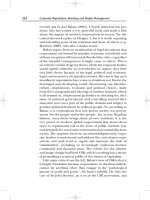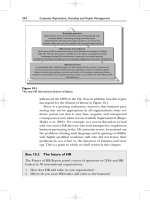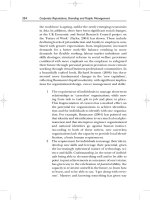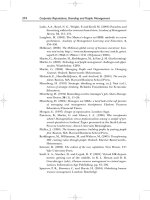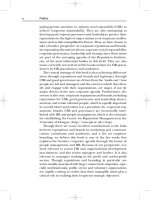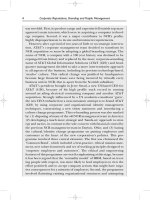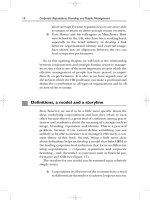Corporate Reputations, Branding and People Management 35
Bạn đang xem bản rút gọn của tài liệu. Xem và tải ngay bản đầy đủ của tài liệu tại đây (102.45 KB, 10 trang )
recently put by Joel Bakan (2004), a North American law pro-
fessor, who has written a very powerful book and made a film
about the impact of modern corporations in society. We dis-
cussed this work earlier in Chapter 1, but it is worth repeating
and extending some of his criticisms and those of others (e.g.
Monbiot, 2000), who take a similar stance.
Bakan argues from an examination of legal documents that
corporations are bound by mandate to pursue relentlessly and
without exception self-interested shareholder value, regardless
of the harmful consequences it might cause to others. This is
an extreme version of agency theory, which few corporate leaders
would openly subscribe to; nevertheless, he argues, they have
very little choice because of the legal, political and economic
logics and structures of capitalist societies. His view is that such
mandated corporations have come to dominate our lives in the
developed and developing world, determining our lifestyles,
culture, employment, economic and political choices. Aside
from the iconography and ideology of modern business, which
is all around us, corporations go further in dictating the deci-
sions of national governments and controlling societal deci-
sions that were once part of the public domain and subject to
genuine political decisions by ordinary people. So, according to
Bakan, it is corporations that now govern society, not govern-
ments ‘for the people and by the people’. Yet, in true Hegelian
fashion, every thesis brings about its own antithesis: it is the
very power of modern, global corporations that leaves them
open to reputational risk in the form of public mistrust, fear
and demands for social and environmental accountability from
society. The response has been an acknowledgement by corpo-
rate leaders to understand and address the costs of poor repu-
tations, and work hard to regain and maintain the trust of
‘stakeholders’, including an increasingly vociferous investor
community and financial press. The vehicle for this identity
and image change had been CSR, which is nothing but a means
of persuading a sceptical public of the virtues of capitalism.
Like many critics from the left, Bakan’s view of CSR is that it
is largely fraudulent because corporations, in the final analysis,
cannot do anything other than engage in the ‘pathological
pursuit of profit and power’, his book’s subtitle. He cites the
case of Sir John Browne, an icon of the CSR movement, and
324 Corporate Reputations, Branding and People Management
BP’s pursuance of a green agenda as a mask behind which to
‘maintain consumer demand for petrochemicals’:
The days when our business had a captive market for oil are
probably ending … So we have to compete to ensure that
oil remains the fuel of choice (quote from Sir John Browne).
(Bakan, 2004, p. 46)
On the potential for CSR, Bakan concludes:
More generally, for Browne and all other business leaders,
social and environmental goals are, and must be, strategies
to advance the interests of their companies and shareholders;
they can never legitimately be pursued as ends in
themselves … (p. 46)
Criticisms from within
Bakan’s thesis is predicated on CSR being an important move-
ment in society, yet even its adherents remain unconvinced of
some of the arguments and evidence used to support it. First,
the business case for CSR has often rested on the assumption
that ‘doing good leads to doing well’; that creating product or
service differentiation through CSR is a way of satisfying the
firm’s needs for superior profits and serving societal goals. Daniel
Diermeier (2006), a CSR supporter, has tempered this argu-
ment with a view that it is really long-run cost reduction that is
the best justification for CSR, because it is concerned with man-
aging the downside of reputation risk rather than the upside of
differentiation. Note the similarity between this argument and
Bakan’s, but for very different reasons.
Diermeier began his thesis by making a values case for CSR,
claiming that values matter and that the values of the newer
generations in advanced industrial societies are more inclined
to be post-materialist, with a concern for the environment, tol-
erance and social issues that are different from the materialist
values of earlier generations that were influenced by hardship.
Moreover, he argues that these values will remain relatively
Chapter 9 Corporate strategy, corporate leadership, corporate identity 325
permanent throughout the lifetime of this new generation, pre-
cisely because their formative years were shaped by times of
plenty rather than hardship. The consequences, according to
Diermeier, are that the shift to CSR is real and permanent
(though our example of young financial analysts earlier may be
seen as evidence of influential ‘Neanderthals’, or as the excep-
tion that breaks this ‘rule’). As a result, companies will be pressed
into responding to these value-changes by outsiders and insiders,
especially when competing in the global market for talent.
However, CSR issues are likely to vary in the same way that cul-
tural values vary; some emerging economies not only cannot
afford CSR but do not value it so highly because the values of
their nationals have been formed under conditions of relative
hardship, exacerbated by the growing gaps between rich and
poor and by the impact of modern communications in high-
lighting that gap to the poor. One only needs to see the good
life invoiced by the skyline of San Diego in California from the
run-down squalor of Tijuana in Mexico, literally within viewing
distance, to have this gap rammed home forcibly.
The consequences of these value-changes for competitive
positioning are that businesses must be able to adapt their strate-
gies to different segments of product markets (and employment
markets), as we have consistently argued throughout this book.
As Diermeier argues, for a product differentiation strategy to
work by creating and capturing value from customers for socially
responsible brands (e.g. the Body Shop or Patagonia), three
factors have to be present:
■ Customers must be willing to pay more for socially
responsible goods and services to cover the fixed and
variable costs of providing them, implying that cus-
tomers must be willing to pay sufficiently high mar-
ginal prices and the market segment must be large
enough to cover the fixed costs.
■ Socially responsible brands must be difficult to imitate
to allow for both socially responsible and non-socially
responsible brands to coexist.
■ The claims for social responsibility must be credible
and customers must be able to verify these claims in
some way.
326 Corporate Reputations, Branding and People Management
Thus, in sufficiently large markets, it is possible for firms to
earn superior profits from socially responsible brands by charg-
ing a premium price for them if these three conditions hold.
And there are examples of markets in which socially responsible
brands do earn superior profits through charging more for their
goods and services, such as the food market in which organic
and ‘fair play’ producers are carving out a niche.
However, the case for CSR does not really rest on this ‘doing
business by doing good’ argument, but in lowering long-run
costs. This, Diermeier argues, is the main argument for CSR: it
does not rest on offering higher consumption value to willing
consumers, which is difficult for them to verify anyway, but in
delivering goods and services at lower costs to the environ-
ment, which is simply a principle of good management and is
independent of offering higher value. To prove his point he
used the example of the contrast between BP and Shell in the
1990s. Clearly, there is only a small segment willing to pay higher
prices for a commodity product such as petrol for their cars but
BP’s strategy is not driven by a differentiation strategy in small
segment markets; it is driven by its reputation for CSR and in
protecting it. Shell, on the other hand, has had a number of
problems with its reputation, resulting from its confrontation
with Greenpeace, its proposed disposal of rigs in deep water,
and in its operations in Nigeria where human rights were an
issue. As a result, Shell has had to invest heavily in CSR to lower
its costs arising from reputational risk in the long run and has
had to work very hard to catch up with BP in particular markets.
However, this will only be worthwhile if the expected savings from
avoiding reputational damage are greater than the costs of com-
plying with CSR practices. So in essence these are cost-driven
strategies, arising from the nature of the markets they operate in,
not price differentiation, which is the usual justification.
This argument can also be extended to the market for talent.
While there may be niche markets for talented people who are
attracted by working for companies that offer socially respon-
sible goods and services, more people are likely to be attracted to
and remain with organizations with a history of avoiding damage
to their reputations, since the individual reputations of talented
individuals are likely to suffer from association with firms that
have not invested in avoiding reputational damage.
Chapter 9 Corporate strategy, corporate leadership, corporate identity 327
Criticisms of measurement
While the idea of a triple bottom line has appeal to a number of
firms and government departments that have used it in their pub-
lic relations, including BT, AT&T, Shell and Dow Chemicals, the
UK government and state governments in Australia, critics point
out some fundamental problems with it, even as a metaphor.
These are based on the contention that what is sound about 3BL
isn’t novel and what is novel isn’t measurable (Norman and
MacDonald, 2004). The claims of its proponents, in line with
stakeholder theories of governance, are that firms should assess
their overall long-term contribution to society as well as to share-
holders, that the social and environmental impact of firms can be
measured in much the same way as the financial impact and that
these individual measures can be aggregated to provide some-
thing akin to a societal profit or loss. While those adhering to the
strict shareholder value version of corporate governance, such as
the editors of The Economist, may take issue with the first of these
claims, in no way could they be regarded as novel, according to
Norman and MacDonald, since they have been at the heart of the
CSR agenda since the 1980s. The more important criticism, how-
ever, lies in the measurement aspects of 3BL.
First, there are no known, universally accepted standards for
measuring an aggregated bottom line, and given different ver-
sions of ethics in business, it is probably not theoretically possible.
The movement known as SEAAR, social and ethical accounting,
auditing and reporting, which is probably the most rigorous body
in this field, has influenced a number of standard-setting bodies
in the past few years, including the Global Reporting Initiative,
SA 8000 Workplace/employee relations, AccountAbility 1000
Stakeholders, ISO 9000 Organization and Governance standards
(see Fombrun, 2005), but would not claim to have provided an
aggregate measure of 3BL. Their job has been to identify per-
formance indicators of the social and ethical behaviour of com-
panies and to find ways of auditing it. However, this is some way
short of providing valid and reliable aggregate measures of CSR,
which is the novel claim of 3BL. Indeed, to be plausible, the con-
cept has to remain vague, qualitative and generalized; the closer
one gets to specifying a measure of 3BL, the less plausible it
becomes.
328 Corporate Reputations, Branding and People Management
